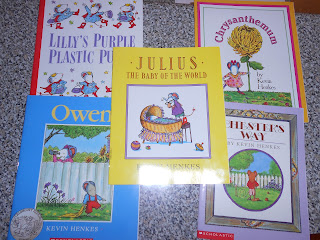Bing, C. (2000). Casey at the bat. New York, NY: Scholastic Inc.
Amazing! I love love love this! I spent a little more time than I wanted in finding my poetry selection for this week. I was sitting in the children's section of the library, near the beanbags (which I used my better judgment and didn't sit down on them) with a huge stack of poetry books. Most of them were collections of poetry which I was surprised at how many curriculum connections I was making just browsing but none of them really caught my attention. I checked out 5 poetry books. On my Thanksgiving break I started reading a few. When I came to this one, I knew I had found the one! I had heard of this poem but had never read it myself. I am a huge sports fan (and I still love to play softball and basketball). I was also intrigued by the illustrations! This book is a Caldecott Honor book. This famous poem written by Ernest Lawrence Thayer was published on June 3, 1888 in the San Fransisco Examiner, Christopher Bing, the illustrator published Thayer's poem in 2000.
The poem is written in the voice of a narrative poem, telling the story of Casey, the all-star baseball great who the fans are cheering for to bring his "Mudville nine" to victory with a game winning hit. The poem is written in the form of a Ballad, each 4 line stanza is displayed on the two-page spread. Each 4 line stanza follows the "aabb" rhyme scheme, for example:
"There was ease in Casey's manner as he stepped into his place; a
There was pride in Casey's bearing and a smile on Casey's face. a
And when, responding to the cheers, he lightly doffed his hat, b
No stranger in the crowd could doubt 'twas Casey at the bat." b
Throughout the poem, Thayer builds up the excitement towards Casey's at-bat, the reader thinks Casey might win the game for his team but unfortunately he watches strike one, strike two and then a swing and a miss! Casey struck out and his team lost the game! The vocabulary in this poem lead me to think it is a picture book for older students, maybe 5th-8th grade, and even at the higher grade levels, some of the language can be a bit confusing and might need some guidance from the teacher. This might a good opportunity for students to use post-it notes for unknown vocabulary.
Who doesn't love baseball!? This is a great chance for young boys and girls to get excited about poetry - probably doesn't seem "cool" at this age but there are so many choices of poems that refer to sports that the young men especially can relate to, using sports poetry would even be a great motivation for a coach to share with the players! Why did Casey act the way he did? Was he over confident? Has there been a time when you were in Casey's shoes?
The illustrations by Christopher Bing is what really pulls you in. The pictures look like the were pulled straight out of an 1800's newspaper! Even "cooler" are the ads and side articles, there is even one that references the Negro League. There can be many American History connections made with this poem. The illustrations are black and white drawings created with pen, ink, and brush. A great read for anyone, especially the sports fans!








